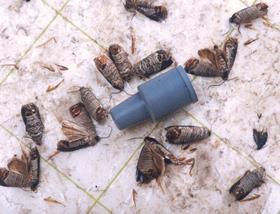
US researchers have developed new lures to help apple and pear growers control codling moths in their orchards.
The moths’ larvae are major pests of top fruit, but can be controlled with timely insecticide applications. Scientists at the US Department of Agriculture’s Agriculture Research Service (ARS) have developed lures that entice codling moths with the scent of food and synthetic versions of the adult female moth’s sex pheromone. This helps growers refine their timing of insecticide applications and reduce the amount applied.
As part of research to improve the technology further, researchers have identified and synthesised new compounds to use with the sex pheromone. Among these are pear ester and acetic acid.
Pear ester alone is a potent attractant for both sexes of codling moth. Adding acetic acid significantly increases the number caught. However, the research team found that the most powerful lure resulted from combining pear ester, sex pheromone and acetic acid. The team's studies indicated that the combined lure can capture eight to 10 times more female moths than using the pear ester-pheromone combination alone.
The researchers also developed action thresholds based on both female and total moth catches that enabled growers to reduce their pesticide applications by 30 to 70 per cent.
The research was led by Alan Knight, Peter Landolt and Douglas Light from ARS sites in the states of Washington and California.



